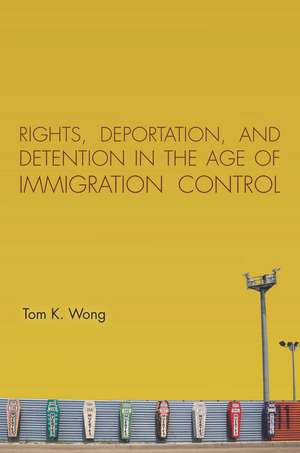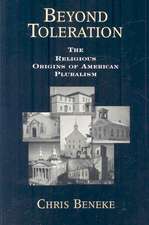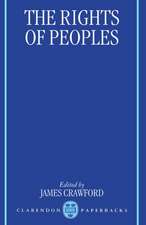Rights, Deportation, and Detention in the Age of Immigration Control
Autor Tom Wongen Limba Engleză Hardback – 12 mai 2015
In addition to answering the question of why states do what they do, the book describes contemporary trends in what Tom K. Wong refers to as the machinery of immigration control, analyzes the determinants of these trends using a combination of quantitative analysis and fieldwork, and explores whether efforts to deter unwanted immigration are actually working.
Preț: 446.46 lei
Preț vechi: 551.19 lei
-19% Nou
85.43€ • 88.27$ • 71.07£
Carte tipărită la comandă
Livrare economică 19 martie-02 aprilie
Specificații
ISBN-10: 0804793069
Pagini: 256
Dimensiuni: 152 x 229 x 20 mm
Greutate: 0.48 kg
Editura: Stanford University Press
Colecția Stanford University Press
Recenzii
Notă biografică
Cuprins
This chapter presents an overview of contemporary trends in immigration control. In contrast to the view that immigration control is a deterministic outcome of national sovereignty, this chapter argues that the various mechanisms used by governments to control immigration are policy outputs that emerge from the broader political and institutional context in which the contentious politics of immigration unfolds and takes place. It defines what immigration control is, discusses debates over the objectives of immigration control, and uses insights gained from fieldwork and qualitative interviews to show why the view that "illegal means illegal" is too simplistic when it comes to understanding how the contemporary machinery of immigration control works. It then lays out the main arguments and chapters of the book.
This chapter examines and inventories what the human rights of migrants are as a matter of international human rights law, focusing on rights in the context of deportation and immigration detention. It examines the role that human rights play in the context of immigration control by analyzing the determinants of the ratification of international human rights treaties that require states to extend rights protections to noncitizens, focusing on the Migrant Workers Convention (ICRMW). It argues and finds that because treaties such as the ICRMW impose high sovereignty costs on states, meaning they increase the distance between what states want to do with respect to immigration control and what they can do as parties to these treaties, they are not likely to be ratified. Consequently, emergent human rights norms related to noncitizens have yet to become fully instantiated in the domestic legal frameworks that govern the machinery of immigration control.
What are the politics and determinants of deportation? This chapter investigates this question by analyzing data across twenty-five immigrant-receiving countries from 2000 to 2009. It represents one of the first systematic, cross-national, and over time studies of deportation and its political, economic, and migration-related determinants. The main argument of the chapter is that while the economic and societal implications of immigration may harden public attitudes, thus increasing the demand for greater policy restrictiveness, the extent to which this demand is translated into policy outcomes hinges on the political landscape in which the politics of immigration plays out. In other words, public preferences do not directly translate into immigration control outcomes, as political institutions mediate these preferences. More specifically, electoral institutions play a role in channeling restrictive preferences over immigration into policy outputs by providing opportunities for the legislative representation of far-right political parties.
What are the politics and determinants of immigration detention? This chapter begins by discussing the labyrinthine processes of immigration detention. It then describes conditions of immigration detention in the U.S. and Europe, including cases of death during detention. Mounting international case law criticizing the detention practices of immigrant-receiving democracies, the legal principle of proportionality, arbitrary detention, and inhuman and degrading treatment and punishment are also discussed. The second part of the chapter is the empirical analysis. While immigration detention has become an increasingly prominent component in the machinery of immigration control, it remains unclear what explains its prevalence across Western immigrant-receiving democracies. Moreover, while the immigration industrial complex is rapidly expanding in some countries, this is not the case for all of the countries that are experiencing large-scale immigration. What explains these cross-national variations? I use new comparative data on immigration detention to address these questions.
Does the increased restrictiveness of immigration control reduce unwanted immigration? Despite its fundamental policy importance, this question remains almost entirely unanswered in the scholarly literature. The main argument of the chapter is that because tighter immigration controls do not fundamentally change the motives of migrants, the increased restrictiveness of immigration control does not necessarily mean less unwanted immigration. Using deportations as an indicator of immigration control, and while accounting for some of the most enduring explanations given for immigration, the analysis provides evidence to support this argument. The data indicate that increased restrictiveness is not significantly related to immigrant inflows and is only weakly related to asylum inflows. These results add to the growing skepticism over whether current modes of immigration control actually deter unwanted immigration.
The conclusion reviews the main empirical findings of the book and discusses the territory that remains uncharted in the study of immigration control, focusing on the role that immigrants qua political actors may play in shaping the future of immigration control policies.

















